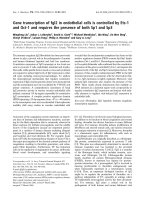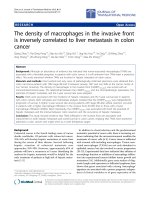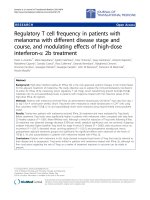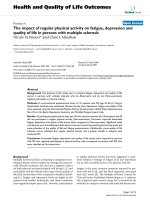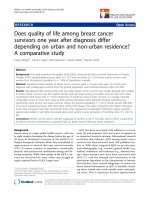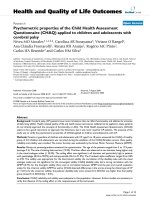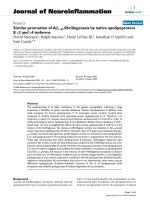báo cáo hóa học: " Health-related Quality of Life in Vacuum-Assisted Breast Biopsy: short-term effects, long-term effects and predictors" ppt
Bạn đang xem bản rút gọn của tài liệu. Xem và tải ngay bản đầy đủ của tài liệu tại đây (435.74 KB, 10 trang )
RESEARC H Open Access
Health-related Quality of Life in Vacuum-Assisted
Breast Biopsy: short-term effects, long-term
effects and predictors
Philip J Domeyer
*
, Theodoros N Sergentanis, Flora Zagouri, George C Zografos
Abstract
Background: The impact of Vacuum-assisted breast biopsy (VABB, 11-Gauge) upon Health-related Quality of Life
(HRQoL) remains an open field. This study aims to: i) assess short-term (4 days after VABB) responses in terms of
HRQoL after VABB, ii) evaluate long-term (18 months after VABB) responses, if any, and iii) examine whether these
responses are modified by a variety of possible predictors (anthropometric, sociodemographic, lifestyle habits,
breast-related parameters, reproductive history, VABB-related features and complicati ons, seasonality).
Methods: This study included 102 eligible patients undergoing VABB and having benign lesions. A variable
number of cores (24-96 cores) has been excised. HRQoL was assessed by EQ-5D and SF-36® questionnaires: i) in
the morning of the VABB procedure day (baseline measurement), ii) four days after VABB (early post-biopsy
measurement) and iii) 18 months after VABB (late post-biopsy measurement). Statistical analysis comprised two
steps: i. evaluation of differences in EQ-5D/SF-36 dimensions and calculated scores (baseline versus early post-
biopsy measurement and baseline versus late post-biopsy measurement) and ii. assessment of predictors through
multivariate linear, logistic, ordinal logistic regression, as appropriate.
Results: At baseline patients presented with considerable anxiety (EQ-5D anxiety/depression dimension, EQ-5D
TTO/VAS indices, SF-36 Mental Health dimension). At the early post-biopsy measurement women exhibited
deterioration in Usual Activities (EQ-5D) and Role Functioning-Physical dimensions. At the late me asurement
women exhibited pain (EQ-5D pain/discomfort and SF-36 Bodily Pain), deterioration in Physical Functioning (SF-36
PF) and overall SF-36 Physical Component Scale (PCS). Mastalgia, older age and lower income emerged as
significant predictors for baseline anxiety, whereas seasonality modified early activities-related responses. Pain
seemed idiosyncratic.
Conclusions: The HRQoL profile of patients suggests that VABB exerts effects prior to its performance at a
psychological level, immediately after its performance at a functioning-physical level and entails long-term effects
associated with pain.
Background
Vacuum-Assisted Breast Biopsy (VABB) is a recently
developed biopsy method, aiming to obtain tissue for
histopathological diagnosis of non-palpable mammo-
graphic lesions. VABB can be performed under stereo-
tactic or ultrasonographic guidance; an 11-Gauge (11G)
needle is most commonly used for sampling of the sus-
picious lesion [1]. Although its role for sampling non-
palpable breast lesions is already well established, the
impact of VABB with 11-Gauge (11G) needle on health-
related quality of life (HRQoL) has never been
investigated.
We have already shown that psychological stress,
which is an important aspect of HRQoL, is present
before, during and after VABB, as depicted by the note-
worthy increase in blood concentrations of stress hor-
mones [2]. Furthermore, according to a study issued b y
our Unit, pain in women undergoing V ABB is s ignifi-
cant and follows an S-shape curve pattern; indeed the
diameter of the needle emerged an important predictor
* Correspondence:
Breast Unit, First Department of Propaedeutic Surgery, Hippokratio Hospital,
Medical School, University of Athens, 108 Vas Sofias Ave, Athens 11527,
Greece
Domeyer et al. Health and Quality of Life Outcomes 2010, 8:11
/>© 2010 Domeyer et al; licensee BioMed Central Ltd. This is an Open Access article distributed under the terms of the Creative
Commons Attribution License ( g/licenses/by/2.0), which permits unrestricted use, distribution, and
reproduction in any medium, provided the original work is properly cited.
of pain in different biopsy methods [3]. Apart from
those short-term effects described by our team, mid-
term (4 months after biopsy) effects of stereotactic
breast biopsy have been recognized [4]. Indeed, accord-
ing to our previous work, VABB s eems to exhibit fairly
distinct long-term effects, when compared to other
biopsy methods in terms of compliance [5].
Given the above, it is rational to antic ipate that VABB
may exert significant effects upon HRQoL. Nevertheless,
only two studies (COBRA study [6] and the study issued
by Maxwell et al. [7]) have appeared assessing the
impact of stereotactic core needle biopsy on HRQoL. It
should be stressed however that the COBRA study had
adopted a comparative approach (i.e. stereotactic 14G
needle biopsy versus open breast biopsy) and focused
exclusiv ely on short-term responses, i.e. up to four days
afterbiopsy.SimilarlythestudybyMaxwelletal.has
assessed the 14G setting covering a 30-day period after
core biopsy [7].
As a result, short-term and long-term effects of VABB
(11G) on HRQoL remain an open field. The particulari-
ties in VABB are worth investigating systematically, as
the special features of VABB together with the larger
(11G) needle diameter may exhibit a distinct HRQoL
profile, as documented i n the context of other phenom-
ena such as pain [3]. Importantly, to o ur knowledge, no
insight into predictors modifying the effect of VABB
upon HRQoL has appeared in the literature.
This study aims to: i) assess short-term (4 days after
VABB) responses in terms of HRQoL after VABB, ii)
evaluate long-term (18 months after VABB) responses, if
any, and iii) examine whether these responses are mod i-
fied by a variety of possible predictors (anthropometric,
sociodemographic, lifestyle habits, breast-related para-
meters, reproductive history, VAB B-related features and
complications, seasonality). To our knowledge, this is
the first study to address these issues.
Methods
Patients
Exclusion criteria for this study were: previous breast
cancer, severe comorbidity (psychiatric conditions,
stroke, autoimmune diseases, c ancer, severe coronary
heartfailure,i.e.NYHAstageIIIorIV).Inaddition
patients diagnosed with precursor (atypical ductal hyper-
plasia, ADH and lobular neoplasia, LN) lesions, as well
as carcinomas (ductal, in situ, DCIS or invasive, IDC,
lobular carcinomas) were excluded from the study, as
the follow-up/treatment of these conditions, respectively,
may interfere with HRQoL measurements.
Of the 164 consecutive patients who came to our
Breast Unit d ue to non-palpabl e mammographic lesions
requiring VABB, only 102 were eligible for this study
(Figure 1). The women were 33-80 years old.
Patients were informed (orally and in written) about
the procedure, possibility of pain and complications by
the surgeon performing VAB B. Written signed informed
consent was obta ined from all patients. The study was
approved by the Local Institutional Review Board.
VABB performance - local anesthesia
All patients presenting with a non-palpable mammo-
graphic les ion (microcalcifications, solid lesion or asym-
metric density) BI-RADS 3 o r 4 under went VABB
under stereotactic guidance (11G) on the Fisher’stable
(Mammotest, Fischer Imaging, Denver, CO, USA).
According to the results of a double-blind study [8], a
variable number of cores (24-96 cores) has been
excised.
All procedures were performed by the same surgeon,
in the same Unit, according to the recommended local
anesthesia [1]; in addition two specialist radiologists
assisted at the procedures. The surgeon performing
VABB was familiar with this method before the onset of
this study, having already performed 350 VABB proce-
dures. For local anesthesia, the two-step approach was
adopted: 5 cm
3
1% lidocaine without epinephrine
(superficial) and 10 cm
3
1% lidocaine with epinephrine
(deep) were administered. The biopsy was performed
according to a standard protoc ol to assure quality con-
trol. Compression bandages were applied so as to pre-
vent hematoma.
HRQoL measurement
HRQoL was measured with the EQ-5D [9] and SF-36®
[10] questionnaires. EQ-5D encompasses five dimen-
sions (mobility, self-care, usual activities, pain/discom-
fort and anxiety/depression), eac h one with three levels
(no problems, some problems, extr eme pro blems/
unable). EQ-5D also contains a visual analogue scale on
which patient s rate their own health between 0 and 100
(designated as EQ-5D VAS “thermometer”)[9].Basedon
patients’ responses two indices were cal culated: EQ-
TTO (Time Trade-Off v alues) [11] and EQ-VAS [12];
the n orms of the Spanish population were adopted
under the light of geographical and s ocial proximity.
Importantly no Greek norms have been published to
our knowledge.
The SF-36 questionnaire comprises 36 items covering
eight health dimensions, namely physical functioning
(PF), bodily pain (BP), general health (GH), vitality (VT),
social functioning (SF), mental health (MH), role func-
tioning-physical (RP) and role-functioning-emotional
(RE). It produces a health profile with scores between 0
and 100 for each dimension [10]. Based on ratings two
overall scores were calculated (Physical Component
Scale, PCS and Mental Component Scale, MCS), once
again using the Spanish norms [13].
Domeyer et al. Health and Quality of Life Outcomes 2010, 8:11
/>Page 2 of 10
Structure and administration of questionnaires
All patients were asked to complete SF-36 and EQ-5D
questionnaires simultaneously, i) in the morning of the
VABB procedure day (i.e. 1-2 hours prior to biopsy,
designated as baseline measurement), ii) four days after
VABB (i.e. always prior to obtaining a final diagnosis of
the breast lesion, designated as early post-biopsy mea-
surement) and iii) 18 months after VABB (designated as
late post-biopsy measurement).
At the baseline assessment the following information
was obtained: i) anthropometric features (height, weight,
from which Body Mass Index (BMI) was calculated), ii)
sociodemograph ic parameters i.e. age, plac e of residence
(urban or rural), education (1 = primary education, 2 =
secondary education, 3 = technological educational insti-
tute, 4 = university, 5 = postgraduate university educa-
tion), professional risk (0 = low risk, i. e. permanent
employees and housewives, 1 = high risk, i.e. non-perma-
nent job, for instance in the private sector or self-
employed), marital status (married/living with partner,
single, widowed, divorced), number of offspring (male
and female sepa rately), personal income, ii i) lifestyle
habits (current smoking), iv) breast-related parameters
(mastalgia, presence of fibrocystic disease, breast cancer
history in a first-degree relative, monthly breast self-
examination, duration of breastfeeding), v) reproduc tive
history (menopausal status, age at menarche, age at first
full-term pregnancy, spontaneous abortions, miscar-
riages, number of prior caesarian sections, oral contra-
ceptive/HRT (hormone replacement therapy) ever-use,
vi) VABB-related features [referral, type of le sion (micro-
calcifications, solid lesion, asymmetric density), BI-RADS
classification], vii) seasonality (biopsy month). Moreover,
the volume of tissue excised, subsequent hematoma for-
mation and infection were recorded after VABB. The his-
tology of the lesion was classified according to the system
firstproposedbyDupontandPage[14]andadoptedby
the recent review by Guray and Sahin [15]. At the late
post-biopsy measurement the satisfaction of patients
with the cosmetic result was also recorded.
Figure 1 Flow chart explaining the study design.
Domeyer et al. Health and Quality of Life Outcomes 2010, 8:11
/>Page 3 of 10
Statistical analysis
Statistical analysis is summarized in Figure 2 and com-
prised two steps: 1. e valuation of differences in EQ-
5D/SF-36 dimensions and calculated scores and 2.
assessment of predictors. Concerning step 1, two com-
parisons were made: i. baseline versus early post-biopsy
measurement and ii. baseline versus late post-biopsy
measurement. Given that two comparisons were per-
formed, the Bonferroni correction was adopted, i.e. the
threshold for statistical significance was equal to 0.05/2
=0.025.
Concerning step 2, the following procedure was
followed: i. In case a difference was proven significant
in step 1, the numerical difference was computed in
such a way that the sign of the mean result was posi-
tive; f or example, b aseline minus post-biopsy difference
was calculated for dimens ions where mean baseline =
mean post-biopsy value, whereas post-biopsy minus
baseline difference was calculated for dimensions
where mean post-biopsy = mean baseline value. This
framework was adopted in orde r that the r esults be
more tangible.
ii. After t he calculation of differences two scenarios
were possible: baseline health status was better or worse
than subsequent (early/late) measurements.
It should be kept in mind that the point of focus of
this study is the identification of predictors modifying
the wo rsening (aggravation) of HRQoL at any time
point before or after VABB. In an attempt to reach tan-
gible and plausible results the design of the analysis also
took into account the time criterion for causality.
Specifically: a) In case baseline values denoted worse
health status, the multivariate analysis was performed
on baseline values encompassing inherent f eatures i.e.
thos e acting prior to baseline. b ) In case the subsequent
measurements indicated worse health status than base-
line, the analysis was performed on the calculated differ-
ences, encompassing inherent and VABB-related features
as independent variables. The rationale underlying the
setting of differences as dependent variables is the fol-
lowing: given the time criterion, some inherent possible
predictors may have acted both at baseline and at subse-
quent measurements. However, as mentioned above,
this study aims to examine whether predict ors modify
Figure 2 Flow chart explaining the successive steps of the statistical analysis.
Domeyer et al. Health and Quality of Life Outcomes 2010, 8:11
/>Page 4 of 10
(further potenti ate or limit) the aggravating effect of the
procedure; as a result it is the change (gradient) that
had to be modeled.
Concerning model building, the associations between
baseline values or calculated differences and possible
predictors were assessed first through univariate analy-
sis; the predictors proven significant in the univariate
analysis were included in the multivariate models.
Where the assump tions of l inear regression were met,
the former was perfo rmed. When the assumptions of
linear regressions were not met, the difference was con-
vertedtoabinaryvariable(0=values≤ median, 1 =
values above median). Concerning baseline measure-
ments o n EQ-5D dimensions ordinal logistic regression
was performed.
The statistical analysis was performed using STATA
8.0 statistical software (Stata Corporation, College Sta-
tion, TX, USA).
Results
Table 1 outlines the features of the study sample; it is
worth mentioning that no infections or hematomas
requir ing intervention were present in the study sample.
The seven hematomas included in Table 1 are clinically
significant hematomas with a diameter larger than 3 cm.
Table 2 presents the changes in HRQoL in VABB. At
the early measurement significant deterioration was
noted in EQ-5D usual activities and SF-36 RP dimen-
sions; on the other hand EQ-5D anxiety/depression
dimension as well as EQ-5D indices (VAS and TTO)
revealed worse health status at baseline.
Concerning the b aseline-late post-biopsy comparison,
worse health status in the late measurement was demon-
strated through EQ-5D pain/discomfort dimension, SF-36
PF and BP dimensions as well as SF-36 PCS overall score;
on the contrary baseline denoted worse health state in
EQ-5D mobility, anxiety/depression, VAS “thermometer”
measurements as well as SF-36 MH dimension.
Table 3 presents predictors assessed through the base-
line-early post-biopsy comparison. Biopsy season was
associated with more pronounced worsening in EQ-5D
usual activities dimension; on the contrary greater num-
ber of prior cesarean sections was associated with less
pronounced worsening in SF-36 RP dimension. Regard-
ing the dimensions pointing to worse status in baseline,
mastalgia w as associated with higher degree of anxiety/
depression and, consequently, worse health status as
measured by EQ-5D TTO and VAS indices. Increasing
age was associated with worse baseline EQ-5D TTO and
VAS indices; on the other hand increasing income cor-
related with better baseline EQ-5D TTO values.
Table 4 presents predictors assessed through the base-
line-late post-biopsy comparison. No significant predic-
tors were fo und for the worsening noted in EQ-5D
Table 1 Description of the study sample (n = 102)
Categorical variables Frequency (%)
Sociodemographic parameters and lifestyle habits
Place of residence
Urban 72 (70.6)
Rural 30 (29.4)
Education
Primary education 21 (20.6)
Secondary education 44 (43.1)
Technological educational institute 10 (9.8)
University 22 (21.6)
Postgraduate university education 5 (4.9)
Professional risk
Low (permanent employees and housewives) 68 (66.7)
High (non-permanent job or self-employed) 34 (33.3)
Marrital status
Married/living with partner 84 (82.3)
Single 7 (6.9)
Divorced 5 (4.9)
Widowed 6 (5.9)
Current smoking
Yes 27 (26.5)
No 75 (73.5)
Breast-related parameters
Mastalgia
Yes 30 (29.4)
No 72 (70.6)
Presence of fibrocystic disease
Yes 47 (46.1)
No 55 (53.9)
Breast cancer history in a first-degree relative
Yes 8 (7.8)
No 94 (92.2)
Reproductive history
Menopausal status
Premenopausal 43 (42.2)
Postmenopausal 59 (57.8)
Number of prior caesarian sections
None 86 (84.3)
One 7 (6.9)
Two 7 (6.9)
Three 2 (1.9)
VABB-related features and histological classification
Histological classification
Nonproliferative lesions
Mild epithelial hyperplasia 9 (8.8)
Ductal ectasia 5 (4.9)
Nonsclerosing adenosis 1 (1.0)
Periductal fibrosis 4 (3.9)
Multiple coexisting nonproliferative lesions 15 (14.7)
Proliferative lesions
Moderate ductal hyperplasia without atypia 15 (14.7)
Domeyer et al. Health and Quality of Life Outcomes 2010, 8:11
/>Page 5 of 10
pain/discomfort and SF-36 BP dimensions. Mastalgia
was associated with more marked deterioration in SF-36
PF dimension and PCS overall score; int erestingl y cur-
rent smo king and being married seemed to play a pro-
tective role for SF-36 PF and SF-36 PCS deterioration,
respectively. Concerning the dimensions s uggesting
worse status at baseline, age was associated with worse
EQ-5D mobili ty status and worse EQ-5D VAS “thermo-
meter” values; similarly mastalgia unfavorably modified
EQ-5D VAS “thermometer” and SF-36 MH. Personal
income predicted better health status as measured by
EQ-5D mobility dimension.
Patients were satisfied with the cosmetic result (75/78,
96.2%); satisfaction with the cosmetic result was not
associated with any HRQoL measurement. Noticeably
the histology of lesions was not associated with any
HRQoL measurement.
Discussion
This study is the first to document that VABB is capable
of modifying HRQoL in a multifaceted, complex way.
Interest ingly enough, the effects of VABB upon HRQoL
seem to have begun well before the biopsy procedure
per se. Strikingly, patients’ anxiety prior to biopsy is so
considerable that it led to significantly worse overall
(VAS and TTO) HRQol EQ-5D indices when compared
to the early post-biopsy measurement. As a result, a pat-
tern emerges, according to which women come to the
biopsy procedure with already aggravated HRQoL (Fig-
ure 3). The existence of this phenomenon is methodolo-
gically and conceptually challenging, as the true baseline
remains elusive, being located prior to the suspicious
mammogram. It is worth mentioning that our result are
in accordance with previously published studies, which
have documented significant anxiety prior to other
methods of breast biopsy [7,16]. As a result awaiting a
biopsy for a potential malignancy emerges as a factor
capable of creating anxiety irrespective of the method of
biopsy.
Apartfromtheabovefinding,VABBwascapableof
generating subst antial short- and long-term effects upon
subjects’ HRQoL. At the early measurement, a limitation
of the capability to perform usual activities (EQ-5D) and
deterioration of the SF-36 Role Functioning-Physical
scale point to pain and discomfort after the procedure.
Interestingly enough, this study points additionally to
long-term pain after VABB, as reflected upon the
directly relevant late mea surements of EQ-5D pain/dis-
comfort scale and the SF-36 Bodily Pain dimensions, as
well as possibly upon the SF-36 Physical Component
Scale overall score. To our knowledge, this is the first
time that such an observation i s reported in the litera-
ture. Long-term effects of VABB, such as scar formation
[17,18], have been reported, especially in the context of
greater tissue amount excised [17]. Whether the under-
lying, scar formation-related distortions of breast archi-
tecture together with inflammatory phenomena may be
accompanied by long-term pain is an issue that has
never before been addressed.
Maki ng one step beyond the demonstration o f sign ifi-
cant changes, this study has investigated the existence of
predictors capable of modifying the responses of women
in terms of HRQoL before and after VABB. The predic-
tors may be schematically divided into those affecting
the baseline, mainly anxiety-related, status and those
affecting subsequent, early or late, responses.
Concerning baseline, mastalgia emerged as a particular
risk factor for anxiety, acting unfavorably upon EQ-5D
anxiety/depression dimension, EQ-5D thermometer,
EQ-5D overall VAS and TTO indices, as well as SF-36
Mental Health dimension. It seems fairly rational to
postulate that women who have experience d mastalgia
are more concerned about their breast health and thus
present with more pronounced anxiety. In addition,
mastalgia has been associated with a host of conditions
Table 1: Description of the study sample (n = 102)
(Continued)
Sclerosing adenosis 7 (6.9)
Radial scar 1 (1.0)
Intraductal papilloma 5 (4.9)
Intraductal papillomatosis 1 (1.0)
Multiple coexisting proliferative lesions 13 (12.7)
Fat necrosis 1 (1.0)
Fibroadenomas
Without coexisting lesions 11 (10.8)
With coexisting nonproliferative lesions 8 (7.8)
With coexisting proliferative lesions 6 (5.9)
BI-RADS classification
BI-RADS 3 36 (35.3)
BI-RADS 4 66 (64.7)
Hematoma
Yes 7 (6.9)
No 95 (93.1)
Biopsy season
Spring 28 (27.5)
Summer 26 (25.4)
Autumn 31 (30.4)
Winter 17 (16.7)
Continuous variables Mean ± SD
(median)
Age (years) 51.3 ± 8.8 (50.5)
BMI (kg/m
2
) 25.4 ± 3.9 (24.8)
Personal income (euro) 870 ± 860 (735)
Number of offspring 1.8 ± 1.0 (2.0)
Volume of tissue excised (cc) 4.0 ± 3.2 (3.0)
Domeyer et al. Health and Quality of Life Outcomes 2010, 8:11
/>Page 6 of 10
including mood disorders, post-traumatic stress disor-
der, eating disorders and pain-related conditions [19],
which may interfere with measurements of anxiety.
Apart from mastalgia, lower income and older age were
risk factors for worse HRQoL prior to biopsy, rather
expectably.
Regarding e arly effects of VABB, biopsy season was a
risk factor for worsening in EQ-5D usual activities scale.
This may be explainable, if the bulk of subjects’ every-
day, usual activities is taken into account; usual activities
are more demanding in winter, compared to the lower
pace in summer. It is worth mentioning that seasonality
may not be safely extrapolated to other cultures or
countries, as this effect of su mmer may represent a
Greek or Mediterranean particularity. Concerning early
effects, it is also worth reporting that prior c aesarian
sections were associated with less pronounced
deterioration in SF-36 Role Functioning-Physical scale,
suggesting that women who have undergone previo us
gynecological surgery seem more “resistant” to early
unfavorable effects of VABB; in other words, women
with prior caesarian sections may be accustomed to
temporary or short-term pain.
Commenting on late effects, a striking finding is that
long-term pain (EQ-5D pain/discomfort and SF-36 Bodily
Pain dimensions) seemed rather idiosyncratic, since none
of the predictors examined, including the volume of tissue
excised, was proven significant. One possible explanation
of this observation may be the fact that sampling was per-
formed at the “higher limits” i.e. above 24 cores; as a result
the threshold of significant pain might already have been
reached at 24 cores. Another explanation might essentially
entail breast size as a confounder, i.e. background correla-
tion between larger number of excised cores and larger
Table 2 Baseline, early and late post-biopsy HRQoL measurements
Variables Baseline
(mean ±
SD)
Early post-biopsy
measurement
(mean ± SD)
p§ Late post-biopsy
measurement
(mean ± SD)
p † Practical
interpretation
EQ-5D dimensions and indices
Mobility* 1.41 ± 0.49 1.42 ± 0.50 0.782 1.27 ± 0.45 0.011 Deterioration at
baseline
Self-care* 1.03 ± 0.17 1.03 ± 0.17 1.000 1.09 ± 0.33 0.058 No changes
Usual activities* 1.24 ± 0.43 1.31 ± 0.46 0.021 1.23 ± 0.45 0.835 Short-term
deterioration
Pain/discomfort* 1.53 ± 0.59 1.55 ± 0.61 0.977 1.71 ± 0.54 0.004 Long-term
deterioration
Anxiety/depression* 1.98 ± 0.65 1.52 ± 0.61 <0.0001 1.77 ± 0.60 0.002 Deterioration at
baseline
VAS “thermometer” 68.8 ± 18.4 67.5 ± 18.1 0.406 75.5 ± 15.6 0.003 Deterioration at
baseline
EQ-5D index
(TTO method)
0.729 ±
0.224
0.787 ± 0.208 0.005 0.769 ± 0.225 0.251 Deterioration at
baseline
EQ-5D index
(VAS method)
0.834 ±
0.076
0.854 ± 0.062 0.038 0.845 ± 0.085 0.324 Deterioration at
baseline
SF-36 dimensions and scores
Physical functioning 86.2 ± 19.5 85.2 ± 18.9 0.641 80.1 ± 19.4 0.0001 Long-term
deterioration
Bodily pain 78.3 ± 26.4 76.3 ± 27.5 0.414 65.5 ± 30.5 0.0004 Long-term
deterioration
General Health 64.5 ± 21.3 68.5 ± 22.5 0.067 65.6 ± 19.0 0.700 No changes
Vitality 60.6 ± 19.5 60.8 ± 18.7 0.999 59.6 ± 21.9 0.697 No changes
Social Functioning 75.3 ± 24.7 74.6 ± 25.3 0.496 73.4 ± 27.6 0.925 No changes
Mental Health 58.8 ± 19.3 60.4 ± 20.2 0.139 62.8 ± 21.1 0.030 Deterioration at
baseline
Role functioning-physical 80.1 ± 33.1 72.3 ± 39.2 0.008 73.4 ± 39.0 0.098 Short-term
deterioration
Role functioning-emotional 71.0 ± 37.0 70.9 ± 37.1 0.650 66.2 ± 42.1 0.347 No changes
Physical Component Scale 52.5 ± 8.6 51.8 ± 7.9 0.234 48.5 ± 9.3 0.004 Long-term
deterioration
Mental Component Scale 40.1 ± 11.8 41.5 ± 11.6 0.270 41.9 ± 14.3 0.568 No changes
§ p-values derived from Wilcoxon matched-pairs signed-ranks test (early post-biopsy measurement vs. baseline)
†: p-values derived from Wilcoxon matched-pairs signed-ranks test (late post-biopsy measurement vs. baseline)
*: Measures where a higher score denotes a worse health status
Domeyer et al. Health and Quality of Life Outcomes 2010, 8:11
/>Page 7 of 10
Table 3 Predictors emerging through the assessment of baseline vs. early post-biopsy measurement
Dimensions where early post-biopsy measurement denoted worse health status than baseline
Dimensions/scores Category or increment OR or Coeff. §
(95%CI)
p
EQ-5D Usual activities OR (95% CI)
Biopsy season summer!autumn/spring!winter 8.65 (1.99-37.51) 0.004
SF-36 RP Coeff. (95% CI)
Number of prior caesarean sections 1 procedure increase -12.3 (-24.8, +0.2) 0.053
Dimensions where baseline measurement denoted worse health status than early post-biopsy*
EQ-5D Anxiety/depression OR (95% CI)
Mastalgia yes vs no 3.22 (1.11-9.35) 0.032
EQ-5D index (TTO) Coeff. (95% CI)
Age 10 year increase -0.06 (-0.12, -0.01) 0.025
Personal income 100 euro increase 0.008 (-0.0004, 0.016) 0.061
Mastalgia yes vs no -0.16 (-0.27, -0.04) 0.010
EQ-5D index (VAS) Coeff. (95% CI)
Age 10 year increase -0.02 (-0.04, -0.003) 0.014
Mastalgia yes vs no -0.05 (-0.09, -0.01) 0.017
* The analysis was performed on baseline values
§Coeff. was yielded from linear regression, OR (odds ratio) was derived from logistic regression in the case of EQ-5D Usual activities and from ordinal logistic
regression in the case of EQ-5D Anxiety/depression.
Table 4 Predictors emerging through the assessment of baseline vs. late post-biopsy measurement
Dimensions where late post-biopsy measurement denoted worse health status than baseline
Dimensions/scores Category or increment OR or Coeff. §
(95% CI)
p
EQ-5D Pain/discomfort No significant predictors found
SF-36 Physical Functioning Coeff. (95% CI)
Mastalgia yes vs no 13.4 (5.1, 21.8) 0.002
Current smoking yes vs no -8.1 (-16.6, +0.5) 0.063
SF-36 Bodily Pain No significant predictors found
SF-36 Physical Component Scale Coeff. (95% CI)
Mastalgia yes vs no 8.6 (2.2, 15.1) 0.010
Marital status married vs single/divorced/widowed -9.4 (-16.5, -2.3) 0.010
Dimensions where baseline measurement denoted worse health status than late post-biopsy*
EQ-5D Mobility OR (95% CI)
Age 10 year increase 1.81 (1.00-3.28) 0.051
Personal income 100 euro increase 0.88 (0.80-0.95) 0.002
EQ-5D Anxiety/depression
Mastalgia
See Table 3
EQ-5D VAS “thermometer” Coeff. (95% CI)
Age 10 year increase -8.0 (-12.6, -3.5) 0.001
Mastalgia yes vs no -13.6 (-23.2, -4.1) 0.006
SF-36 Mental Health Coeff. (95% CI)
Mastalgia yes vs no -20.0 (-29.5, -10.5) <0.001
* The analysis was performed on baseline values
§Coeff. was yielded from linear regression, OR (odds ratio) was derived from logistic regression in the case of EQ-5D Mobility.
Domeyer et al. Health and Quality of Life Outcomes 2010, 8:11
/>Page 8 of 10
breast size. Although breast size was not included in the
study design and in thus unavailable, it should be declared
that the consecutive cases in this study have been derived
from a wider pool of patients 1:1 randomly allocated to 24
and 96 cores (i.e. extension of our double-blind study [8]).
As a result the effect of unknown confounders such as
breast size should be considered minimal, if any. Never-
theless, future studies stratifying results would be of inter-
est so as to gain more detailed insight into the
phenomenon of long-term pain.
Further commenting on late effects, once again mastal-
gia emerged as an unfavorable risk factor, being associated
with more pronounced deterioration in SF-36 Physical
Functioning dimension and overall SF-36 Physical Com-
ponent Scale. Surprisingly enough, smoking emerged as a
favorable factor, limiting the deterioration in SF-36 Physi-
cal Functioning dimension; it is tempting to attribute this
finding to analgesic and stress-modulating effects of nico-
tine (reviewed in [20]). Another favorable factor is marital
status, as married patients displayed a better profile in SF-
36 Physical Component Scale overall score; this may
reflect the supportive role of the partner.
This study, however, bears certain limitations that
should be addressed. Firstly, some features of our setting
need to be clarified. In our study, VABB was exclusively
performed under stereotactic guidance. Therefore, the
results may not be extrapolated to ultrasound-guided
VABB. Indeed, given that one of the major complaints
of patients undergoing stereotactically-guided VABB is
the discomfort experienced in a prone position [5],
ultrasound-guided VABB might be better tolerated and
might consequently exhibit a different pattern of early
effects upon HRQoL. Envisaging comparative studies
assessing V ABB (stereotactically- vs ultrasound-guided)
or even encompassing other biopsy procedures, e.g. core
biopsy, would be promising; however the present study
has not adopted a comparative study design leaving the
field open for future studies.
In addition, the fact that all biopsy procedures have
been performed by a surgeon does not obligatorily
reflect breast radiologists’ practice; this may be a sig-
nificant limitation which should be born in mind for
the extrapolation of these findings to other settings.
Nevertheless the exact nature of differences between
Figure 3 Theoretical framework explaining the anxiety demonstrated prior to VABB. Double-dashed lines indicate the phases included in
the study (baseline, early post-biopsy and late post-biopsy).
Domeyer et al. Health and Quality of Life Outcomes 2010, 8:11
/>Page 9 of 10
surgeons’ and radiologists’ practice remains to be elu-
cidated in future comparative studies. An additional
limitation which should be considered prior to any
efforts of extrapolation is the number of cores excised
in our setting; 24-96 cores represent a relatively large
volume of tissue removed in comparison to other set-
tings [8]. Moreover, the proportion of women lost in
follow-up(24/102)mightrepresentalimitation,as
optimal compliance to follow-up would be desirable.
Furthermore, a limitation pertaining to analgesia [21]
is worth add ressing; although analgesia was not pre-
scribed to any patient, the potential over-the-counter
use of paracetamol ca nnot be excluded. An additional
limitation is the fact that no classification of mastalgia
was adopted (cyclic, noncyclic). Nevertheless, this
study points to the need for further studies assessing
the impact of specific features of mastalgia upon
HRQoL.
An important limitation concerning the analysis of
data should be acknowledged. Mixed-effects models
represent the optimal solution for longitudinal data;
however, given our relatively sma ll sample size, the
necessary number of variables and interactions (for the
simultaneous assessment of time trends and modifying
effects of inherent clinical variables) would render the
implementation of such models not robust enough.
Consequently we had to proceed to separate General-
ized Linear Models analyses, as presented above.
Conclusions
The HRQoL profile of patients suggests that VABB
exerts effects prior to its performance at a psychological
level, immediately after its performance at a function-
ing-physical level and entailslong-termeffectsasso-
ciated with pain. Mastalgia, older age and lower income
emerged as significant predictors for baseline anxiety,
whereas seasonality modified early activities-related
responses. Pain seemed idiosyncratic.
Authors’ contributions
PJD conceived the idea of the study, designed the study, acquired data,
performed statistical analysis, interpreted data in the context of the
international literature and drafted the manuscript. TNS designed the study,
performed statistical analysis, interpreted data and drafted the manuscript.
FZ acquired data, interpreted data and revised the manuscript critical ly for
important intellectual content. GCZ designed the study, performed VABB,
revised the manuscript for important intellectual content and gave final
approval of the version to be published.
Competing interests
The authors declare that they have no competing interests.
Received: 6 September 2009
Accepted: 27 January 2010 Published: 27 January 2010
References
1. Dershaw DD: Imaging-guided interventional breast techniques New York, NY:
Springer 2003.
2. Gounaris A, Zagouri F, Sergentanis TN, Provatopoulou X, Kalogera E,
Sagkriotis A, Bramis J, Zografos GC: Vacuum-assisted breast biopsy: insight
into stress-induced endocrine events. In Vivo 2007, 21:1081-1084.
3. Zagouri F, Sergentanis TN, Gounaris A, Koulocheri D, Nonni A, Domeyer P,
Fotiadis C, Bramis J, Zografos GC: Pain in different methods of breast
biopsy: Emphasis on vacuum-assisted breast biopsy. Breast 2008,
17:71-75.
4. Witek-Janusek L, Gabram S, Mathews HL: Psychologic stress, reduced NK
cell activity, and cytokine dysregulation in women experiencing
diagnostic breast biopsy. Psychoneuroendocrinology 2007, 32:22-35.
5. Zografos GC, Sergentanis TN, Zagouri F, Domeyer P, Giannakopoulou G,
Tsigris C, Bramis J: Biopsy method: a major predictor of adherence after
benign breast biopsy?. Accepted in AJR Am J Roentgenol .
6. Verkooijen HM, Buskens E, Peeters PH, Borel Rinkes IH, de Koning HJ, van
Vroonhoven TJ, COBRA Study Group: Diagnosing non-palpable breast
disease: short-term impact on quality of life of large-core needle biopsy
versus open breast biopsy. Surgical Oncology 2002, 10:177-181.
7. Maxwell JR, Bugbee ME, Wellisch D, Shalmon A, Sayre J, Bassett LW:
Imaging-Guided Core Needle Biopsy of the Breast: Study of
Psychological Outcomes. Breast J 2000, 6:53-61.
8. Zografos GC, Zagouri F, Sergentanis TN, Nonni A, Koulocheri D, Fotou M,
Panopoulou E, Pararas N, Fotiadis C, Bramis J: Minimizing underestimation
rate of microcalcifications excised via vacuum-assisted breast biopsy: a
blind study. Breast Cancer Res Treat 2008, 109:397-402.
9. The EuroQoL group: EuroQoL-a new facility for the measurement of
health related quality of life. Health Policy 1990, 16:199-208.
10. Ware JE: SF-36® Health Survey Update. />shtml#MODEL.
11. Badia X, Roset R, Herdman M, Kind P: A comparison of GB and Spanish
general population time trade-off values for EQ-5D health states. Med
Decis Making 2001, 21:7-16.
12. Badia X, Roset M, Monserrat S, Herdman M: The Spanish VAS tariff based
on valuation of EQ-5D health states from the general population.
EuroQol Plenary meeting Rotterdam 1997, 2-3 October. Discussion papers
Rotterdam: Centre for Health Policy & Law, Erasmus UniversityRabin RE,
Busschbach JJV, Charro FThd, Essink-Bot ML, Bonsel GJ 1998, 93-114.
13. Unitat de Recerca en Serveis Sanitaris, Institut Municipal d’Investigació
Mèdica: Manual de puntuación de la versión española del Cuestionario de
Salud SF-36 Barcelona: IMIM 2000.
14. Dupont WD, Page DL: Risk factors for breast cancer in women with
proliferative breast disease. N Engl J Med 1985, 312:146-151.
15. Guray M, Sahin AA: Benign breast diseases: classification, diagnosis, and
management. Oncologist 2006, 11:435-449.
16. Hughson AV, Cooper AF, McArdle CS, Smith DC: Psychosocial morbidity in
patients awaiting breast biopsy. J Psychosom Res 1988, 32:173-180.
17. Zagouri F, Sergentanis TN, Koulocheri D, Zografos GC: Vacuum-assisted
breast biopsy: more cores, more scars?. Clin Radiol 2008, 63:736-737.
18. Yazici B, Sever AR, Mills P, Fish D, Jones SE, Jones PA: Scar formation after
stereotactic vacuum-assisted core biopsy of benign breast lesions. Clin
Radiol 2006, 61:619-624.
19. Johnson KM, Bradley KA, Bush K, Gardella C, Dobie DJ, Laya MB: Frequency
of mastalgia among women veterans. Association with psychiatric
conditions and unexplained pain syndromes. J Gen Intern Med 2006,
21(Suppl 3):S70-75.
20. Xue Y, Domino EF: Tobacco/nicotine and endogenous brain opioids. Prog
Neuropsychopharmacol Biol Psychiatry 2008, 32:1131-1138.
21. Thurley P, Evans A, Hamilton L, James J, Wilson R: Patient satisfaction and
efficacy of vacuum-assisted excision biopsy of fibroadenomas. Clin Radiol
2009, 64:381-385.
doi:10.1186/1477-7525-8-11
Cite this article as: Domeyer et al.: Health-related Quality of Life in
Vacuum-Assisted Breast Biopsy: short-term effects, long-term effects
and predictors. Health and Quality of Life Outcomes 2010 8:11.
Domeyer et al. Health and Quality of Life Outcomes 2010, 8:11
/>Page 10 of 10
